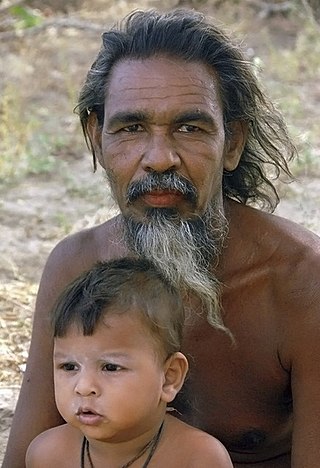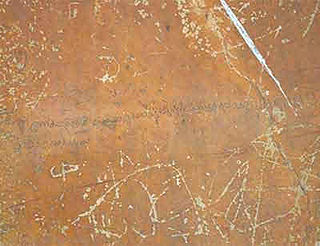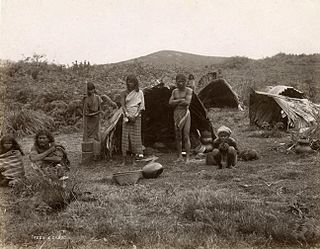Related Research Articles

The Sinhalese people, also known as the Sinhalese are an Indo-Aryan ethno-linguistic group native to the island of Sri Lanka. Historically, they were also known as the Helas or the Lion People. They are the largest ethnic group in Sri Lanka, constituting about 75% of the Sri Lankan population and number more than 16.2 million.

The Vedda, or Wanniyalaeto, are a minority indigenous group of people in Sri Lanka who, among other sub-communities such as Coast Veddas, Anuradhapura Veddas and Bintenne Veddas, are accorded indigenous status. The Vedda minority in Sri Lanka may become completely assimilated. Most speak Sinhala instead of their indigenous languages, which are nearing extinction. It has been hypothesized that the Vedda were probably the earliest inhabitants of Sri Lanka and have lived on the island since before the arrival of other ethnic groups in India.

The Sinhala script, also known as Sinhalese script, is a writing system used by the Sinhalese people and most Sri Lankans in Sri Lanka and elsewhere to write the Sinhala language as well as the liturgical languages Pali and Sanskrit. The Sinhalese Akṣara Mālāva, one of the Brahmic scripts, is a descendant of the Ancient Indian Brahmi script. It is also related to the Grantha script.

Sinhala, sometimes called Sinhalese, is an Indo-Aryan language primarily spoken by the Sinhalese people of Sri Lanka, who make up the largest ethnic group on the island, numbering about 16 million. Sinhala is also spoken as the first language by other ethnic groups in Sri Lanka, totalling about 2 million people as of 2001. It is written using the Sinhala script, which is a Brahmic script closely related to the Grantha script of South India.

The Sabaragamuwa Province is one of the nine provinces of Sri Lanka, the first level administrative division of the country. The provinces have existed since the 19th century but did not have any legal status until 1987 when the 13th Amendment to the Constitution of Sri Lanka established provincial councils. The Sabaragamuwa Province contains two districts: Ratnapura and Kegalle. It is named after its former indigenous inhabitants, namely the Sabara, an indic term for hunter-gatherer tribes, a term seldom used in ancient Sri Lanka. Sabaragamuwa University is in Belihuloya.
The Official Language Act , commonly referred to as the Sinhala Only Act, was an act passed in the Parliament of Ceylon in 1956. The act replaced English with Sinhala as the sole official language of Ceylon, with the exclusion of Tamil.
Hugh L. Nevill was a British civil servant, best known for his scholarship and studies of the culture of Sri Lanka.

Rodi or Rodiya are an untouchable Buddhist social group or caste amongst the Sinhalese people of Sri Lanka. Their status was very similar to all the Untouchable castes of India with segregated communities, ritualised begging, economically weakest section of the society.
Demalagattara are a social group or caste amongst the Sinhalese of Sri Lanka. Demalagattara are Theravada Buddhists by religion. They are ethnically Sinhalese but proclaim their Tamil ethnic origins, whereas all other South India-derived castes such as Karave, Salagama, Durave and Berava do not emphasise their Tamil links as part of their assimilation into Sinhalese society.

Parliamentary elections were held in Ceylon in 1956. They were a watershed in the country's political history, and was the first elections fought to realistically challenge the ruling United National Party. The former Leader of the House, S.W.R.D. Bandaranaike who was passed over after the death of the first Prime Minister D. S. Senanayake, crossed over to the opposition to form the Sri Lanka Freedom Party to launch his bid for Prime Minister.

The 1958 anti-Tamil pogrom and riots in Ceylon, also known as the 58 riots, refer to the first island-wide ethnic riots and pogrom to target the minority Tamils in the Dominion of Ceylon after it became an independent dominion from Britain in 1948. The riots lasted from 22 May until 29 May 1958 although sporadic disturbances happened even after the declaration of emergency on 27 May 1958. The estimates of the murders range, based on recovered body count, from 158 to 1,500. Although most of the victims were Tamils, Sinhalese and their property were also affected by retaliatory attacks by Tamil mobs throughout the Batticaloa and Jaffna districts. As the first full-scale race riot in the country in over forty years, the events of 1958 shattered the trust the communities had in one another and led to further polarisation.
Negombo Tamil dialect or Negombo Fishermen's Tamil is a Sri Lankan Tamil language dialect used by the fishers of Negombo, Sri Lanka. This is just one of the many dialects used by the remnant population of formerly Tamil speaking people of the western Puttalam District and Gampaha District of Sri Lanka. Those who still identify them as ethnic Tamils are known as Negombo Tamils or as Puttalam Tamils. Although most residents of these districts identify them as ethnic Sinhalese some are bilingual in both the languages.
The origins of the Sri Lankan Civil War lie in the continuous political rancor between the majority Sinhalese and the minority Sri Lankan Tamils. According to Jonathan Spencer, a social anthropologist from the School of Social and Political Studies of the University of Edinburgh, the war is an outcome of how modern ethnic identities have been made and re-made since the colonial period, with the political struggle between minority Tamils and the Sinhalese-dominant government accompanied by rhetorical wars over archeological sites and place name etymologies, and the political use of the national past.
Sinhala may refer to:

Sri Lankan place name etymology is characterized by the linguistic and ethnic diversity of the island of Sri Lanka through the ages and the position of the country in the centre of ancient and medieval sea trade routes. While typical Sri Lankan placenames of Sinhalese origin vastly dominate, toponyms which stem from Tamil, Dutch, English, Portuguese and Arabic also exist. In the past, the many composite or hybrid place names and the juxtaposition of Sinhala and Tamil placenames reflected the coexistence of people of both language groups. Today, however, toponyms and their etymologies are a source of heated political debate in the country as part of the political struggles between the majority Sinhalese and minority Sri Lankan Tamils.

The main languages spoken in Sri Lanka are Sinhala and Tamil. Several languages are spoken in Sri Lanka within the Indo-Aryan, Austronesian, and Dravidian families. Sri Lanka accords official status to Sinhala and Tamil, and English as a recognised language. The languages spoken on the island nation are deeply influenced by the various languages in India, Europe and Southeast Asia. Arab settlers and the colonial powers of Portugal, the Netherlands and Britain have also influenced the development of modern languages in Sri Lanka. See below for the most-spoken languages of Sri Lanka.
Sinhala slang is used by speakers of the Sinhala language in Sri Lanka, as well as many other Sinhala-speaking individuals.
Vedda is an endangered language that is used by the indigenous Vedda people of Sri Lanka. Additionally, communities such as Coast Veddas and Anuradhapura Veddas who do not strictly identify as Veddas also use words from the Vedda language in part for communication during hunting and/or for religious chants, throughout the island.
References
- ↑ Gunasekara, A comprehensive grammar of the Sinhalese language (1891), pag. 384
